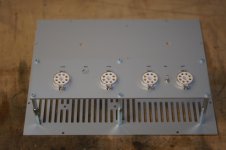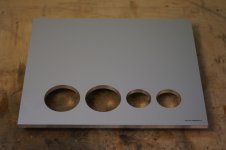Yes the highs are excellent. When I tested it at 10kHz in a square wave I had to double check it was connected through the amp!
And according to Triad the average inductance of the primary is 175H. Very pleased with the results.
Do you have the tools to test the full transfer range (upper and lower -3 dB frequencies, for example)? Would be cool to have some numbers for these power transformers.
I usually hook up my scope to the amp output and an my sine generator to the input. This provides an easy setup to find the cutoff frequencies (where the output is lower than in the pass band by a factor 1.41) and resonances / oscillations (when the ouput goes higher than elsewhere).
The input stage is a choke loaded 6SN7, mainly because I already had the choke and wanted to use it.
Ok, so I worked at bit more on the amp. Turns out the plate choke tends to pick up some 50 Hz hum and harmonics. I could just replace the choke with CCS and be happy, but I'd like to see how far I can take the choke. Any suggestions or hints how to reduce the hum pickup in the choke? Shielding? How?
Yes. By using a CCS in the cathode to balance the DC current in the core some toroidal power transformers work very well as OPTs (And it serves to balance mismatched tubes, too). The bigger the VA rating, the better the bass response. The actual arrangement was inspired by John Broskie of Tubecad.com and George of Tubelab.com, I've just put all the pieces together
I have great results with Triad VPT18 series, which with an 8 ohm speaker reflects a 5.2k Raa. With 4 ohm it's ~1.25k. The VPT12 series is good for when you need 3k or 12k from 8 ohm. The one used in the above schematic is the VPT18-5560. (VPT18-5560 Triad Magnetics | Transformatoren | DigiKey)
The choke is actually 2 Triad C-14X in parallel, and they are cheap, too. (C-14X Triad Magnetics | Induktoren, Spulen, Drosseln | DigiKey)
And you can use this as the power transformer. (VPT230-1090 Triad Magnetics | Transformatoren | DigiKey)
Here's a snap of the finished amp.
Would you happen to have any measurements of how that C-14X performs? There are only a few posts about using a power transformer as an output transformer. Many of them say that it's feasible but that it would never work for hi-fi. It sounds to me like your experience contradicts that.
Which KT66 is the best?
I recently tried to clean up my cellar. I found a bunch of parts that nicely fit together, so I designed and built a new tube amp (Mac Gyver style!). The power stage uses a pair of triode connected KT66 tubes in push pull mode. The general approach to the amp is classic, but there is some help of a sand CCS, a choke plate load (yes, that was also among the parts I found), and an active control for the power tube bias currents.
While designing and building the amp, I got distracted with reading about KT66 tube quality. Some comments touted the NOS GEC KT66 with coated glass (grey glass) as "the best". Sooo, while I was at it, I tested all my 23 KT66 tubes for harmonic distortion in my Mac Gyver amp. The result was, well, a bit boring. As long as the tubes were matched ok, distortion was almost the same for all tubes I tested. I don't know if they sound different, but in terms of harmonic distortion the make/brand, glass coating, base color, or gravitational field anomalies at the production plant did not matter. The numbers are in the attachment, just in case someone is interested.
I recently tried to clean up my cellar. I found a bunch of parts that nicely fit together, so I designed and built a new tube amp (Mac Gyver style!). The power stage uses a pair of triode connected KT66 tubes in push pull mode. The general approach to the amp is classic, but there is some help of a sand CCS, a choke plate load (yes, that was also among the parts I found), and an active control for the power tube bias currents.
While designing and building the amp, I got distracted with reading about KT66 tube quality. Some comments touted the NOS GEC KT66 with coated glass (grey glass) as "the best". Sooo, while I was at it, I tested all my 23 KT66 tubes for harmonic distortion in my Mac Gyver amp. The result was, well, a bit boring. As long as the tubes were matched ok, distortion was almost the same for all tubes I tested. I don't know if they sound different, but in terms of harmonic distortion the make/brand, glass coating, base color, or gravitational field anomalies at the production plant did not matter. The numbers are in the attachment, just in case someone is interested.
Attachments
Good point.
Using different valves can make a difference if not biased correctly.
Being from and being brought up on different makers, I found that they are all of a muchness ... no, all within the designated specification. It is only when one steps outside that one finds a Svetlana EL34 or KT88, (KT120 is a new idea) will give more power, because it is not the same specification.
My 1965 XLCH 1000cc Harley has never had the heads off for any major maintenance. How many Yamaha bikes can boast that!
Go by the specification, any good quality manufacturer will meet or exceed it.
Using different valves can make a difference if not biased correctly.
Being from and being brought up on different makers, I found that they are all of a muchness ... no, all within the designated specification. It is only when one steps outside that one finds a Svetlana EL34 or KT88, (KT120 is a new idea) will give more power, because it is not the same specification.
My 1965 XLCH 1000cc Harley has never had the heads off for any major maintenance. How many Yamaha bikes can boast that!
Go by the specification, any good quality manufacturer will meet or exceed it.
KT66 were just made by the english MOV subsidiary of GEC, so the only differences you will find between KT66 is due to manufacturing changes. There is a date and factory code to clarify manufacture, and the external differences of base colour, and internal graphite coating will indicate date ranges, and there was a late change in getter cup/halo.
Your amplifier uses linear circuits, plenty of gain, push pull KT66s in triode mode, and negative feedback. The amp distortions are likely less than most loudspeakers that are driven with 5 Watts.
Try using the same basic amp, but modify it for a little less gain, and remove the negative feedback (all this may be easier said than done properly).
Now do your distortion measurements at 5 Watts, with different pairs of the KT66s.
Then listen to the different KT66 pairs, perhaps at a level of 5 Watts.
Now what do you measure?
Now what do you hear?
Try using the same basic amp, but modify it for a little less gain, and remove the negative feedback (all this may be easier said than done properly).
Now do your distortion measurements at 5 Watts, with different pairs of the KT66s.
Then listen to the different KT66 pairs, perhaps at a level of 5 Watts.
Now what do you measure?
Now what do you hear?
Last edited:
I was told the KT66 is more linear for audio than other KT, this is correct?
What is the KT66 sound quality aside EL34 and KT88?
Thanks
Last time I looked at the curves of these tubes, the KT66 in triode mode looked the most linear to me. Just look at the curves and decide yourself.
KT66 were just made by the english MOV subsidiary of GEC, so the only differences you will find between KT66 is due to manufacturing changes. There is a date and factory code to clarify manufacture, and the external differences of base colour, and internal graphite coating will indicate date ranges, and there was a late change in getter cup/halo.
MOV/GEC produced KT66 tubes for a few decades, so I would not be surprised if there were a few changes to the tube during that time. For instance, the different glass coatings, which might be related to distortion (Morgan Jones wrote a few lines about this in his book). Also, other manufacturers made KT66 tubes after GEC stopped production (Russian, Chinese).
In any case I could not see any clear differences in distortion with the measurements in my amp (different glass coatings, different manufacturers). Yes, the global NFB may take care of some of the distortion. However, the amount of NFB is quite a bit less than in other such amps following the same topology, and the gain in the input and driver stages is less than with the typical 6SL7 or ECC83 input tubes. But it's probably a good idea to repeat some of those measurements with the NFB removed.
MOV has obviously kept the averaged performance curves the same over the decades. Any glass coating and material changes would not have changed that performance.
If anything, unit to unit variation tolerances may have changed (improved). Unless your testing accounts for those expected variations then take any measurements or observations with some caution - many a blind test for 'quality' has been fooled when volume levels were just slightly different.
If anything, unit to unit variation tolerances may have changed (improved). Unless your testing accounts for those expected variations then take any measurements or observations with some caution - many a blind test for 'quality' has been fooled when volume levels were just slightly different.
MOV has obviously kept the averaged performance curves the same over the decades.
What do you mean by performance curves?
Thanks Bro, I will try understand thats lines.Last time I looked at the curves of these tubes, the KT66 in triode mode looked the most linear to me. Just look at the curves and decide yourself.
- Status
- This old topic is closed. If you want to reopen this topic, contact a moderator using the "Report Post" button.
- Home
- Amplifiers
- Tubes / Valves
- What to build with KT66 and some other parts?

